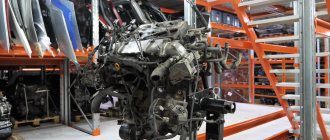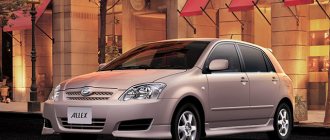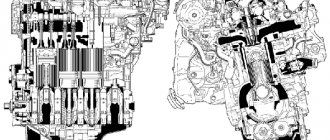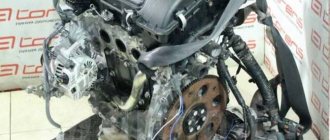Many say and write that they do not see the difference between these “identical” cars... it is not visible, BUT it IS!
Let's start with the external differences of the body or how to quickly determine who is who
?
And another secret... if there is a plastic molding on the doors, the car has a super or semi-super interior; if there is no molding, the interior is “wooden” or, in extreme cases, only the driver’s door is super-bathed.
Equipment.
. (for those who already understand everything, don’t need to read further)
Toyota Succeed and Probox are presented in the categories Van - cargo-passenger and Wagon-passenger version. To find out what equipment you need, you need to look at the trunk lid on the left side. Succeed Van
- this is the basic U and more advanced UL and UL "X package"
Succeed Wagon
- TX / TX "G package"
Probox Van
— DX, DX — J, DX “Comfort package” and “GL”.
There is no exact correspondence between these versions, since the most advanced GL version of the Probox Van is approximately the same as the “medium” UL version of the Succeed Van. And, again, the simplest version of the Probox Van DX demonstrates literally the ultimate simplicity, featuring minimal equipment (complete absence of electric drives) and having a very inconvenient low-lying bench for rear passengers. Probox Wagon
, here two versions are offered for each model: F / F “Extra package”
However, air conditioning, several cup holders, a retractable table, as well as at least one airbag and ABS + EBD are present in any case. Toyota Succeed and Probox in the maximum configuration sometimes have velor seats:
Engine:
Over the entire production period, the Probox / Succeed station wagons were equipped with four different engines: two gasoline (volume 1.3 and 1.5 liters), one diesel (1.4 liters) and one engine running on natural gas 1 NZ - FNE (its in They do not transport it to Russia due to the impossibility of operating it on the Russian propane-butane mixture (in Japan they use natural gas CNG, which consists of 98% methane). Diesel engine 1 ND - TV: we have this in single copies. The Common Rail power system assumes special demands on the quality and purity of diesel fuel, as well as high repair costs. The most common engine for Probox / Succeed is a 1.5-liter
This engine is found in more than a dozen different Toyota models. The resource itself of 1 NZ - FE is quite large - there have already been cases when these motors calmly take care of a couple of hundred thousand kilometers and continue to do their job. On September 26, 2011, Probox 2008 was sold at the JU Tokyo auction, lot No. 5107. Mileage at the time of sale according to the auction list is 999.999 km. (link to the auction house) As for the 1.3-liter (2 NZ - FE), its life path due to higher loads (due to lower volume and power) is shorter.
The Toyota Motor Corporation station wagon fleet is quite extensive. A worthy place in it is occupied by an offshoot of one of the most recognizable Japanese cars of the last fifty years, the Toyota Corolla. The car, which first rolled off the assembly line in 2000, received the prefix Fielder. In the context of the Japanese automaker's strategy, the literal meaning of the name is “outdoor camper.” By its name itself, the company emphasized the main purpose of the new car - a universal four-wheeled assistant in organizing a pleasant family vacation.
1JZ-GE
1JZ-GE is a true Toyota legend, developed in 1990. This was the first engine in the JZ line, which is now used not only in conventional cars, but also in motorsports. The 1JZ-GE has established itself as a reliable motor that uses the latest technology of its time. At the same time, it is a very powerful unit and easy to operate. This engine was equipped with: Mark II, Cresta, Crown, Chaser and Progres.
The 1JZ-GE consists of 24 valves and has a volume of 2.5 liters. Engine power reaches 200 horsepower at 6000 rpm. The fuel compression ratio is 10.0. The engine was produced in 2 generations. In the first generation it had a distributor ignition, but in the second generation the engineers installed a coil ignition with a VVT-i valve timing system. This increased the power of the 2nd generation by 20 hp. Compared to the first, it also reduced the amount of exhaust gases. The first generation was produced in 1990-1996, the second lived longer, from 1996 to 2007.
The 1JZ-GE engine works great on 92 and 95 gasoline, but problems begin with 98, the engine starts to start worse, although its productivity increases. With proper maintenance, engine overhauls will not be necessary until 400 thousand km. Consumption averages 11 liters per 100 km in the city.
For all its advantages, 1JZ-GE has a number of problems:
- The engine is afraid of frost, so it is not suitable for residents of northern regions.
- Like many other Toyota 1JZ-GE engines, it consumes a lot of oil.
- The engine may knock or knock, as a rule, this is caused by the VVT-i system; to solve the problem, it should be replaced.
To tune the 1JZ-GE, it is enough to install a Walbro 255 pump, buy a Blitz brain, an intercooler and a bloff, this will increase the power by 50 hp.
What are the advantages and disadvantages of Ipsum?
Strengths:
- Appearance . Despite the fact that Ipsum is, for obvious reasons, larger than the Corolla station wagon, Japanese designers successfully managed to hide its true dimensions under neat shapes and smooth lines.
- Spaciousness and practicality of the interior . But inside the minivan is huge. It can accommodate up to 7 people, and the third row is not “children’s” at all - there is enough space for adults both for legs and head. In addition, the cabin is full of niches, stands and other things with which you can easily set up a work area, travel comfortably, or escape bad weather during a picnic.
- Speed . For its category, the car has good dynamics due to a powerful 2.4 liter engine and 160 horses under the hood. The minivan doesn’t even “feel” like a turtle even in active city traffic.
- Controllability . The impressive size of the car does not cause any problems for the driver: the car is stable on long and high-speed turns, and confidently holds its course.
Weak sides:
- suspension is a bit soft for a minivan, this is noticeable when driving on bad roads and when scary rolls occur when cornering.
- Fuel consumption . 8.3 liters in mixed mode - for the current race for efficiency, this is too large a figure, especially in comparison with today's competitor. In winter, consumption in city mode increases to 18-20 liters.
About the model
Toyota Saxid is available in two versions: both passenger and cargo-passenger. It’s worth talking briefly about each.
The passenger version is special in that it is equipped exclusively with an automatic transmission. And under the hood is a 1.5-liter engine known as 1NZ-FE. The cargo-passenger version is equipped with “mechanics” and a diesel power unit.
Both options are popular. By the way, 4 years after the start of production, it was decided to carry out restyling. Thanks to him, it was possible to reduce fuel consumption by 0.08 liters. The developers also slightly changed the on-board computer. But the most important thing in the 2006 restyling was that the specialists managed to reduce exhaust emissions by 50%! In addition, it was decided to add a headlight range control.
Toyota Saxid is not supplied to Russia. But nevertheless, this car is popular in the Far East of our country.
Characteristics
As an example, it is worth considering the technical side of one of the very first models. When production just started, the Toyota Saxid with a 109-horsepower 1.5-liter engine was popular. It is located in front, transversely. It does not have turbocharging, but it does have multipoint fuel injection and a DOHC mechanism. The Toyota Saxid engine has a 4-cylinder.
Even though the engine consumption is small, it is recommended to refuel the car with AI-95 fuel. Ventilated disc brakes are installed at the front and drum brakes at the rear. In principle, these are the main characteristics of the car.
Installed motors
Depending on the configuration, different engines could be installed on the car. Despite the similar volume, the engines have different power, this is due to design features, as well as settings.
Engine Toyota Succeed
If desired, you can purchase a car with gasoline or diesel fuel. In any case, there will be no environmental safety problems. In the table below you can see the main parameters of the motors.
| 1NZ-FE | 1ND-TV | 1NZ-FXE | |
| Engine capacity, cc | 1496 | 1364 | 1496 |
| Maximum torque, N*m (kg*m) at rpm. | 132 (13) / 4400 | 170 (17) / 2000 | 102 (10) / 4000 |
| 132 (13) / 4800 | 190 (19) / 3000 | 111 (11) / 4000 | |
| 133 (14) / 4400 | 205 (21) / 2800 | 110 (11) / 4000 | |
| 135 (14) / 4400 | 111 (11) / 4200 | ||
| 143 (15) / 4200 | 115 (12) / 4200 | ||
| 136 (14) / 4800 | 111 (11) / 4400 | ||
| 137 (14) / 4200 | |||
| 138 (14) / 4400 | |||
| 140 (14) / 4200 | |||
| 138 (14) / 4200 | |||
| 140 (14) / 4400 | |||
| 141 (14) / 4200 | |||
| 142 (14) / 4200 | |||
| 147 (15) / 5200 | |||
| Maximum power, hp | 103 – 119 | 72 – 90 | 58 – 78 |
| Fuel consumption, l/100 km | 4.9 – 8.8 | 04.09.2019 | 2.9 – 5.9 |
| Fuel used | Gasoline Regular (AI-92, AI-95) | Diesel fuel | Gasoline Regular (AI-92, AI-95) |
| AI-95 | AI-95 | ||
| engine's type | 4-cylinder, 16-valve, DOHC | 4-cylinder, SOHC | In-line, 4-cylinder |
| CO2 emissions, g/km | 105 – 151 | 100 – 130 | 61 – 104 |
| Add. engine information | No | direct fuel injection | electronic fuel injection system, VVT |
| Maximum power, hp (kW) at rpm | 103 (76) / 6000 | 72 (53) / 4000 | 58 (43) / 4000 |
| 105 (77) / 6000 | 90 (66) / 3800 | 70 (51) / 4500 | |
| 106 (78) / 6000 | 73 (54) / 4800 | ||
| 108 (79) / 6000 | 78 (57) / 5000 | ||
| 109 (80) / 6000 | 74 (54) / 4800 | ||
| 110 (81) / 6000 | 72 (53) / 4500 | ||
| 119 (88) / 6000 | 76 (56) / 5000 | ||
| 77 (57) / 5000 | |||
| Number of valves per cylinder | 4 | 2 | 4 |
| Start-stop system | optional | No | Optional |
| Supercharger | No | Turbine | No |
| Compression ratio | 10.5 – 13.5 | 16.5 – 18.5 | 13.04.2019 |
| Piston stroke, mm | 84.7 – 90.6 | 81.5 | 84.7 – 85 |
| Cylinder diameter, mm | 72.5 – 75 | 73 | 75 |
| Resource thousand km. | 250+ | 250+ | 250+ |
From the experience of car enthusiasts, one can notice the “love” for high-quality fuel. This factor greatly affects the life of the engine. There are no more difficulties when using it.
Engines for Toyota Corolla Fielder
As with other models whose production marked the beginning of the new century, the list of Fielder engines is extremely short and unified. These are exclusively gasoline engines in the amount of 8 pieces. Many interested participants in Internet forums and experts admit that even on the other side of the Urals it is almost impossible to find a non-production version of a car with a diesel power plant.
| Marking | Type | Volume, cm 3 | Maximum power, kW/hp | Supply system |
| 1NZ-FE | petrol turbocharged | 1496 | 76/103 | DOHC |
| 1ZZ-FE | petrol | 1794 | 107/145 | —:— |
| 2ZZ-GE | —:— | 1795 | 140/190 | —:— |
| 3C-E | —:— | 2184 | 58/79 | OHC |
| 2ZR-FE | petrol with compressor | 1797 | 92/125, 100/136 | DOHC |
| 2ZR-FAE | petrol | 1797 | 106/144, 98/133, 103/140 | DOHC, Valtematic |
| 1NZ-FXE | —:— | 1496 | 54/74 | electronic injection |
| 2NR-FKE | —:— | 1496 | 80/109 | —:— |
What models were they installed on?
To better understand the popularity and efficiency of engines, it makes sense to look at what models they were still installed. We will consider only modifications for the Russian market.
Let's start with 1NZ-FE; this motor is not very often found on officially sold models. Here you can see it on the Toyota Auris, and it was also on the Toyota Corolla. Although in Japan this engine can be found on almost two dozen models.
Engine 1NZ-FE
The 1ND-TV engine was supplied to Russia in some trim levels of Toyota Auris and Toyota Corolla. But, in fact, it is better known as the engine in the Toyota Succeed.
The most popular is 1NZ-FXE. It was also supplied to our country in only two models - Toyota Aqua and Toyota Corolla Axio. But, the motor is installed in the most popular modifications, so the motor is found everywhere.
Car reviews
The reviews of the Japanese car Toyota Corolla Fielder from almost everyone who owns it are positive.
Irkutsk, Konstantin
I came across this Fielder when I was completely desperate to find a suitable station wagon. After calling the owner, I took the device that determines the thickness of the paintwork and went to inspect the car. The temperature was minus 20 degrees, well, not the most comfortable for shopping.
Surprisingly, the device showed that the car, produced in 2004, had never been painted, and other little things: a worn bumper, a loose tailgate mount and the absence of door sills did not bother me, especially since I am not cranky and can do it myself. We took a ride with the owner and listened to the engine. Then we stopped at the service station, determined the amount of investment, bargained as expected, and the car was purchased.
I'm happy with the purchase, I like the car.
The front is on spacers, the ground clearance is high. The 4VD drive drags perfectly, I specifically tested it in snowdrifts, but here we must not be fanatical - it’s just a clutch, not Full Time.
The appearance of the car is pleasing, and the transformation of the interior is pleasantly surprising - there is plenty of space, you can safely transport household items and even skis.
One thing is annoying: the visibility due to the wide A-pillars is insufficient; at first I did not notice pedestrians. And one more thing: there is no door locking after a speed of 20 km/h, as on previous Toyotas, and gasoline consumption is high, but I think that in the summer it will be less.
Vladimir from Novosibirsk
Toyota Corolla - this brand is known to everyone. Immediately after the purchase, I changed the oil in the gearbox and engine, and they did an alignment at the service station. I bought the car in 2008, after restyling, and it has covered 60 thousand km. I can only say good things about it: it starts up without problems in winter, it’s a comfortable and reliable car, fuel consumption when driving around the city is about 8 liters, and on the highway – 5 liters. In four years I covered 100 thousand km and sold it for the same price as I bought it. Friends, take only Toyota, it is practically indestructible, you just need to take care of the engine and change the oil on time. One drawback did appear - vibration when braking. It can be easily fixed - have a turner sharpen the brake disc or buy a new one.
Alexander from Veloyarsk
In 2013, I bought a 2004 Toyota Corolla Fielder, 1.5 liter engine with 4WD drive. Over the past 14 months, “Filya” and I have been in different situations, the engine never let us down, and the all-wheel drive pulled us out of places that are better not to remember. I service the car myself, I have used several different brands before and learned how to do it. I’m changing the silent blocks, shock absorber bushings and rear links on my Fila.
The engine of my favorite is unpretentious and does not cause any problems. Only the idle speed fluctuates - now I’ll clean the throttle valve and the speed will settle down. I like the large and comfortable interior even more; it is dark in color with marble inserts.
PS Sorry, I remembered one drawback - in winter it is impossible to warm up the engine properly at idle speed.
Nikita from Tomsk
I spent a long time looking for and choosing a car, but it happened to be nearby; a friend offered his 2004 Corolla Fielder at a price that was right for me. I took it and never regretted it - not a car, but a fairy tale.
The car picks up speed confidently and dynamically, excellent maneuverability, a spacious trunk and soft plastic panels, starting in any frost - all this somehow charmed me.
Of course, there were breakdowns, but not critical ones. Mostly consumables had to be changed. Prices, naturally, bite, but what to do - demand determines supply. There was no major investment in the car. I drove it for three and a half years and exchanged it for an SUV, and now I regret it. I'm looking for a Fielder again, but now I want a 1.8 engine and a 4WD drive.
Pavel from Ulan-Ude
I purchased this Toyota Corolla Fielder on the Ussuri market. She ran 70 thousand km. The condition of the car was excellent, and I chose it to work as a taxi. Now, after running 350 thousand km, we can say with confidence: it has proven itself perfectly, it was only necessary to change the oil on time.
By 250 thousand km, thrust decreased and detonation appeared when refueling with bad fuel. At 300 thousand km, the speed became unstable, and twitching appeared during transient conditions. It turned out that I just needed to clean the throttle valves.
The manual transmission on the Fielder is excellent, no complaints. The chassis was changed every year, fortunately China is nearby. I think the weak point is the steering rack and front silent blocks. From my own experience I will say that the car is excellent and reliable, only the Probox, which is considered the “younger brother” of the Corolla, is better than it.
Sergey from Vladivostok
Once I was giving a ride to a friend’s house and saw that he had a 2003 Fielder, 1.5 liter engine, 4WD. I asked for a ride and was inspired to buy the same car. I liked the overview and the large internal volume, but the automatic machine added its own drop of ointment. Therefore, I decided to buy a car with a 1.8 liter engine.
I must say, the car is very comfortable, as for the variator, even with the 1.8 engine it is a little dull, but if you switch to manual mode, it picks up speed very quickly.
Consumption measured: on average about 7.8 liters per hundred km. A gas tank with a capacity of 50 liters lasts me for a week. So far I have only positive emotions from the car, and I don’t regret at all that I bought this Filya.
Honda Airwave GJ (Airwave)
https://www.drom.ru/catalog/honda/airwave/g_2008_5006/
Perhaps the most interesting car in my selection, in terms of equipment and appearance. Hondas, most often, have a more complex and more elastic suspension, due to which they stand better on the road than their competitors. Therefore, I would recommend this option to families who travel out of town more often. And the panoramic roof will only contribute to a pleasant time outside the city.
https://www.drom.ru/catalog/honda/airwave/g_2005_850/
https://www.drom.ru/catalog/honda/airwave/g_2005_850/
The Airwave is equipped with only one petrol, 1.5L L15A engine producing 110hp. Also, the car is equipped only with a CVT, but has both front-wheel drive and all-wheel drive in its configurations.
The average price for 2009 is 460,000 rubles.
History of Ipsum
Toyota Ipsum was born in 1996. In total, the model has 2 generations and 2 restylings. After 2009, production was stopped. The first generation was developed on the Toyota Carina platform and was better known as the Toyota Picnic. The car quickly won the love of buyers thanks to its good dynamics, spacious interior and outstanding quality of components even among Japanese cars.
The second generation was released in 2001, it used the base of the popular Avensis, which is why the car was delivered to Europe with the “Avensis Verso” nameplate. Much was expected from the car, but in reality the model rather disappointed. The already large interior has become even larger, it has added bells and whistles, electronics, better upholstery, and improved dynamic performance. But to keep the model in its price category, Japanese designers partially sacrificed the quality of parts, which led to a gradual decline in popularity.
Reviews from Toyota Ipsum 2021 2021 owners
Since its launch, the 2021 Toyota Ipsum has recorded good sales figures. Today, Toyota has decided to complete production of the Toyota Ipsum 2021 model. The car has received the latest technical specifications. Below is an overview of the car, a table of prices and options, as well as reviews from owners.
- Region:
- Select region
Voronezh, st. Ostuzheva, 64
Ekaterinburg, st. Metallurgov 60
Irkutsk, st. Traktovaya 23 A (Lower Angarsky Bridge)
Features of internal corporate policy determine the promotion of certain models in the markets of different countries. Those cars that are popular in Southeast Asia are almost unfamiliar to domestic consumers. However, even on the scale of one country, this is also relevant.
Certain models that are widespread, for example, in the Primorsky region, in Omsk or Barnaul, are almost impossible to find on sale in the Amur region, Chita, Ulan-Ude or Irkutsk. One of these rather interesting, but not widespread models is the Toyota Ipsum compact van.
Sales of the first generation began in 1995. It was then that this model was introduced. The neat compact van had a smooth and streamlined body, a comfortable interior and a fairly good level of equipment for those times.
The engines offered were a 2.2-liter diesel engine or a 2-liter gasoline engine. A 5-speed manual or 4-range automatic transmission was offered as a transmission. An interesting fact is that the car was sold under different names in different markets. So, for example, in Bishkek, you can find the Toyota Ipsum model under the name Toyota Gaya or Toyota Nadya.











